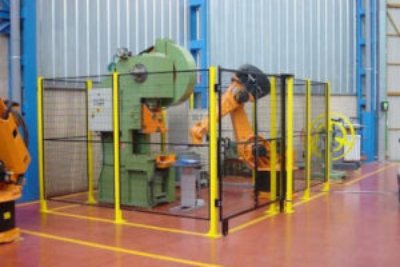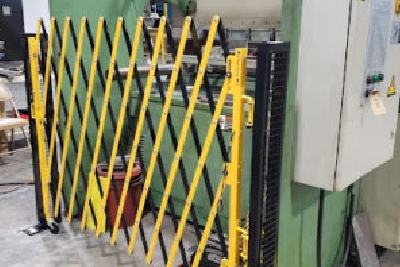Machine guarding equipment is a critical component of any industrial facility or manufacturing environment, as it serves to protect workers from the various hazards that can be present during the operation of machinery. These hazards can include in-going nip points, rotating parts, flying chips and sparks, and others that can cause serious injuries to machine operators and other employees. By implementing machine guarding equipment, facility managers and operators can significantly reduce the risk of injury to workers, while also improving productivity and efficiency by reducing the need for costly shutdowns and repairs.
To effectively protect workers from these hazards, machine guarding equipment must be carefully designed and installed to meet the specific needs of each individual machine and the surrounding work environment. This typically involves guards, barriers, and shields, which are used to physically separate the machine from the worker, creating a safe distance between the two. At North American Safety Products, we offer a range of machine guarding equipment solutions that can be customized to suit your specific facility requirements.
Types of Machine Guarding Equipment
There are four main types of machine guards: fixed, interlocked, adjustable, and self-adjusting.
- Fixed guards. Fixed guards are stationary barriers permanently attached to the machine or the surrounding work area. Fixed guards can be made of a variety of materials, such as sheet metal, Aluminum, plastic, screens, or bars, and they are typically designed to be durable and resistant to damage. Due to its simplicity, this type of machine guarding is often preferred to other types.
- Interlocked guards. When this type of machine guard is removed or opened, the power automatically shuts off and all moving parts of the machine are stopped. The machine cannot resume operation until the guard is back in place. These guards are ideal for instances when operators need to open the guard or access guarded machine components without total disassembly.
- Adjustable guards. Adjustable guards are permanent, but they can be adjusted to allow machinery to work with various material sizes. They must be adjusted manually and properly locked into place to ensure optimal protection. This versatile option can be constructed to meet the needs of many specific applications.
- Self-adjusting guards. These function similarly to adjustable guards, except they automatically adjust to material sizes rather than requiring manual adjustment. When the machine is not in use, these guards sit in the rest position. When the machine is running, materials are fed into the machine, which opens the guard just enough to admit the material. This type of guard protects the operator by creating a barrier between the operator and the hazardous area.
In addition to these four main types of machine guards, there are also a variety of styles of machine guarding equipment that is typically offered by manufacturers. These styles can include wire mesh guards, retractable or “accordion style” guards, cylinder cages, building access and driver cages, panels, and much more. Each of these styles has its own unique features and benefits and is designed to suit the specific needs of the machine or surrounding work area.
Typical Machines Guarded
OSHA requires that certain types of machinery be guarded to protect workers from the hazards associated with their operation. Some of the machines that require point-of-operation guarding include:
- Guillotine cutters
- Power presses
- Alligator shears
- Milling machines
- Shears
- Jointers
- Portable power tools
- Power saws
- Forming rolls and calendars
OSHA also requires that certain other items be guarded, such as revolving drums, containers, and barrels. This can be achieved by using an enclosure that is interlocked with the drive mechanism so that the drum, container, or barrel cannot revolve unless the guard enclosure is in place.
Industry Applications
Machine guarding equipment is used in a wide variety of industries to protect workers from the hazards associated with operating machinery. Some of the common industry applications for machine guards include:
Agriculture: In the agriculture industry, OSHA requires that all farm field equipment, farmstead equipment, and cotton gins be guarded. These guards must be kept in place during machine operation, and employers must install guards, shields, or guarding by location to protect against accidental contact with hazards. These guards must also be securely fastened and free from sharp corners, burrs, and sharp edges.
Manufacturing: In the manufacturing industry, machine guarding is critical for protecting workers from hazards such as rotating parts, belts, gears, and shafts, as well as flying chips and sparks. Manufacturers must ensure that all machinery, such as drill presses, milling machines, lathes, etc., is properly guarded to comply with OSHA regulations and prevent injuries to workers.
Food processing: The food processing industry is another sector where machine guarding is critical, as workers are often at risk of coming into contact with rotating parts, belts, gears, and other hazards. Food processors must ensure that all machinery is properly guarded to prevent injuries to workers and maintain the food product’s safety.
Construction: In the construction industry, OSHA requires that all hand tools, power tools, and similar equipment be equipped with proper machine guarding during use. Components such as chains, flywheels, drums, spindles, sprockets, pulleys, shafts, gears, belts, and other moving, rotating, or reciprocating parts must be guarded if exposed to workers.
Woodworking: The woodworking industry is another sector where machine guarding is essential, as workers are often at risk of coming into contact with rotating parts, belts, gears, and other hazards. Woodworkers must ensure that all machinery, including milling machines, jointers, etc., is properly guarded to prevent injuries and ensure OSHA compliance.
Maritime: Within the maritime industry, OSHA dictates that all hazardous machinery zones must be guarded, enclosed, or fenced by the proper covers, casings, or other guarding solutions. Fixed machinery must be properly secured to prevent movement or shifting, and any machinery containing belts, shafts, wheels, drives, and other rotating parts must have adequate guarding.
Machine Guarding Equipment by North American Safety Products
Machine guarding equipment is a critical component of any industrial or manufacturing setting. It protects workers from hazards such as in-going nip points, rotating parts, reciprocating or traversing parts, flying chips or sparks, and various other machine dangers.
At North American Safety Products, we offer a comprehensive range of machine guarding equipment to meet the needs of our clients. Our solutions include wire mesh kits and accordion style kits that can be customized based on your specific requirements. For more information about our machine guarding capabilities, or for help determining which option is right for your needs, contact us or request a quote today.




